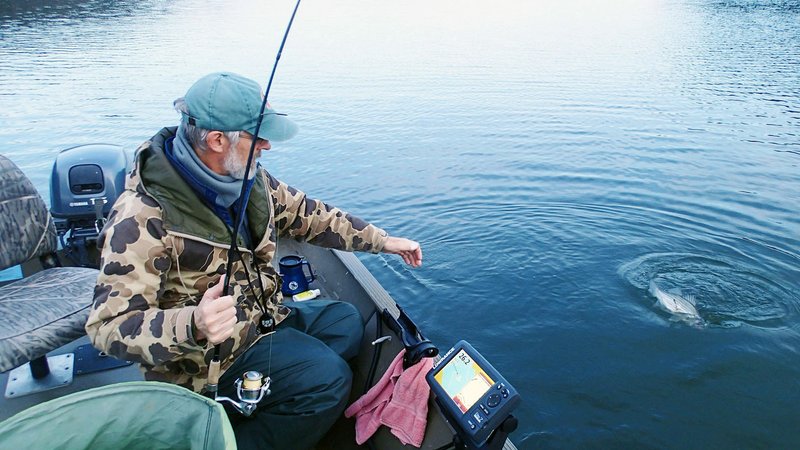Anglers keep an open mind when they fish wide open water far from shore at Beaver Lake. They never know what they'll catch.
It could be a scrappy white bass that's on the hook. Maybe a line-stretching largemouth or spotted bass. If it's a striped bass, a fisherman knows it. Stripers take off like a fired torpedo, testing a reel's drag while it peels off line.
Know the limits
Largemouth and smallmouth bass at Beaver Lake must be 15 inches or longer to keep. There is no size limit on spotted bass at Beaver. The combined daily limit is six.
Striped bass must be 20 inches or longer to keep at Beaver Lake. The daily limit is three. There is no daily limit or length limit on white bass at Beaver Lake or its tributaries.
Source: Arkansas Game and Fish Commission
Bruce Darr likes the guessing game. He lives on the lake east of Rogers and prowls off-shore water searching for schools of threadfin shad. Shad are the forage that all game fish eat. Find the shad and you'll find the fish. Those are words to live by for the off-shore crowd.
Fishing close to the bank is good much of the year for crappie and black bass that like to hang around shoreline trees, rock and gravel. Winter is when working open water can put fish in the boat, sometimes by the dozen.
Cold mornings might find Darr idling along in his aluminum boat with an eye on his depth finder. When schools of shad appear on the unit's screen, Darr stops the boat.
He'll lower a jigging spoon or blade bait over the side of the boat and let it sink. Sometimes a fish nabs it before it hits bottom. Most times, Darr's lure hits bottom, then he jigs it up and down vertically so the lure rises and falls.
On a mild morning in early December shad were thick in the back of a cove near the bottom 25 feet deep. Two schools showed up as big blobs on his depth finder screen. The blade bait sunk like a rock. A couple of twitches and fish No. 1 put a quiver in his fishing rod.
The fighter was a white bass, one of a half dozen Darr caught in the first 30 minutes. Largemouth bass and spotted bass rounded out the morning's mixed catch.
Blade baits are his preferred lure. They're shiny slabs of metal in the shape of a small bait fish, such as a threadfin shad. Line is tied to an eye on top of the lure, where the dorsal fin is on a real bait fish.
"The thing I like about these is they'll catch any fish in the lake. White bass, black bass, walleye, stripers, they'll all hit it," Darr said.
Versatility is another plus for blade baits.
"If you see some fish breaking the surface, you can cast it pretty far to reach them," he noted. "Or you can jig it or even troll with it."
One tactic he uses is to cast the lure, let it sink a few seconds, then twitch the rod tip so the lure does a tantalizing dance. He lets it sink some more and twitches again. That's a good way to catch fish suspended between the surface and the bottom.
The reference book, "Fishes of Arkansas" confirms that white bass prowl open water in large schools looking for food, mainly threadfin shad. The success of white bass in a reservoir is dependent on abundant numbers of shad.
About 9 a.m., Darr's depth finder screen was blank. No more shad, no more white or black bass and no more bites.
"Where did all the fish go?" Darr wondered.
For whatever reason, shad vanish from that cove about 9 a.m. most days. One time, Darr caught a hefty striped bass in the cove during mid afternoon, but early mornings and evenings are best.
Sports on 01/07/2020

